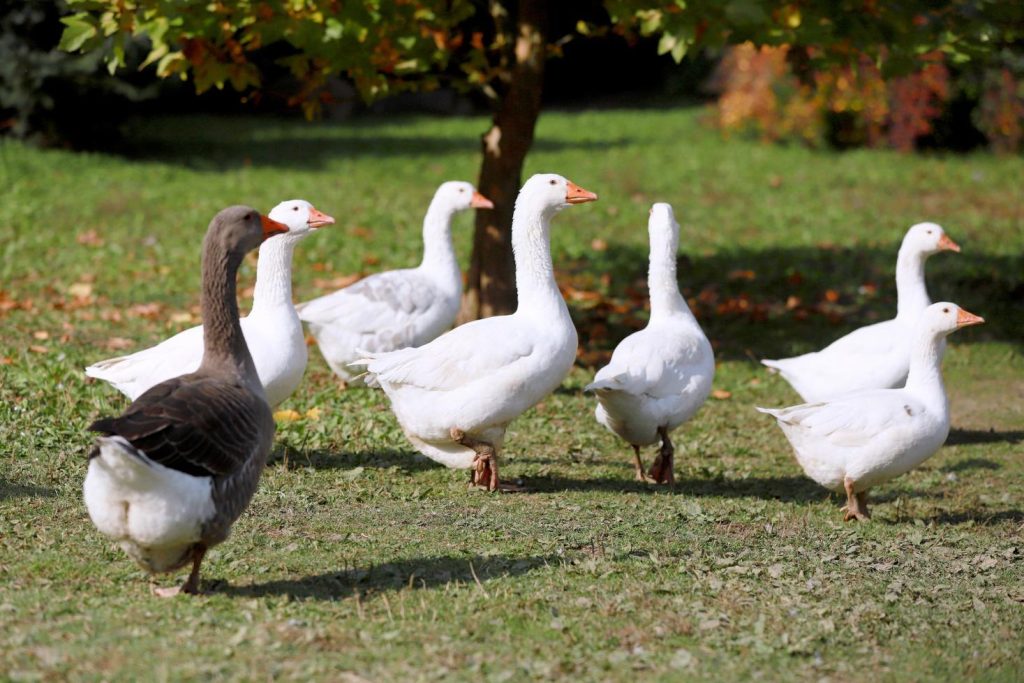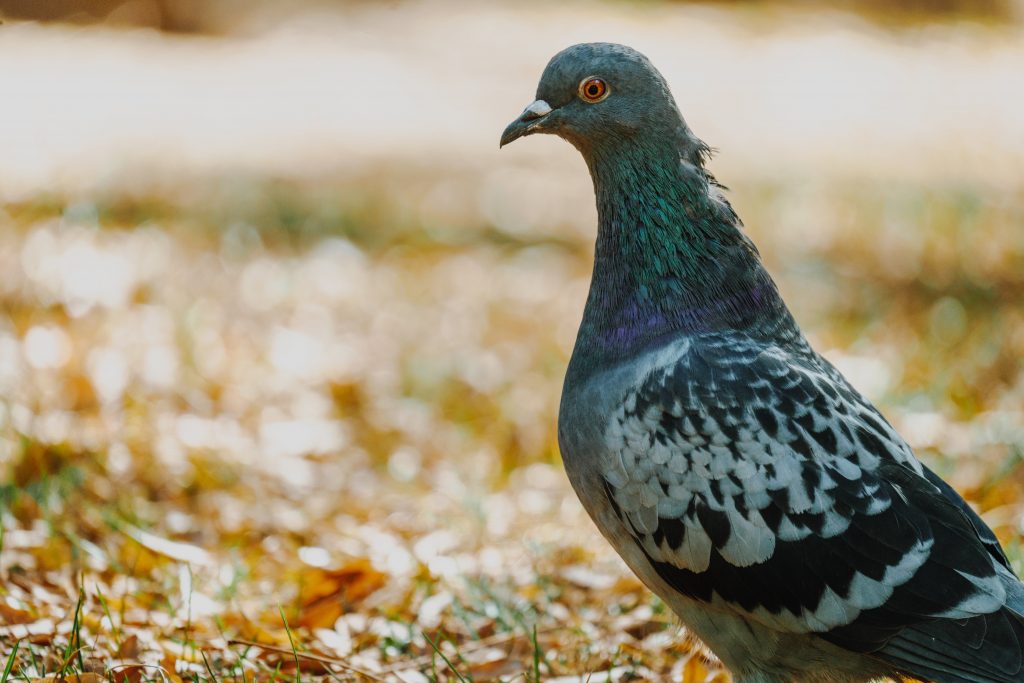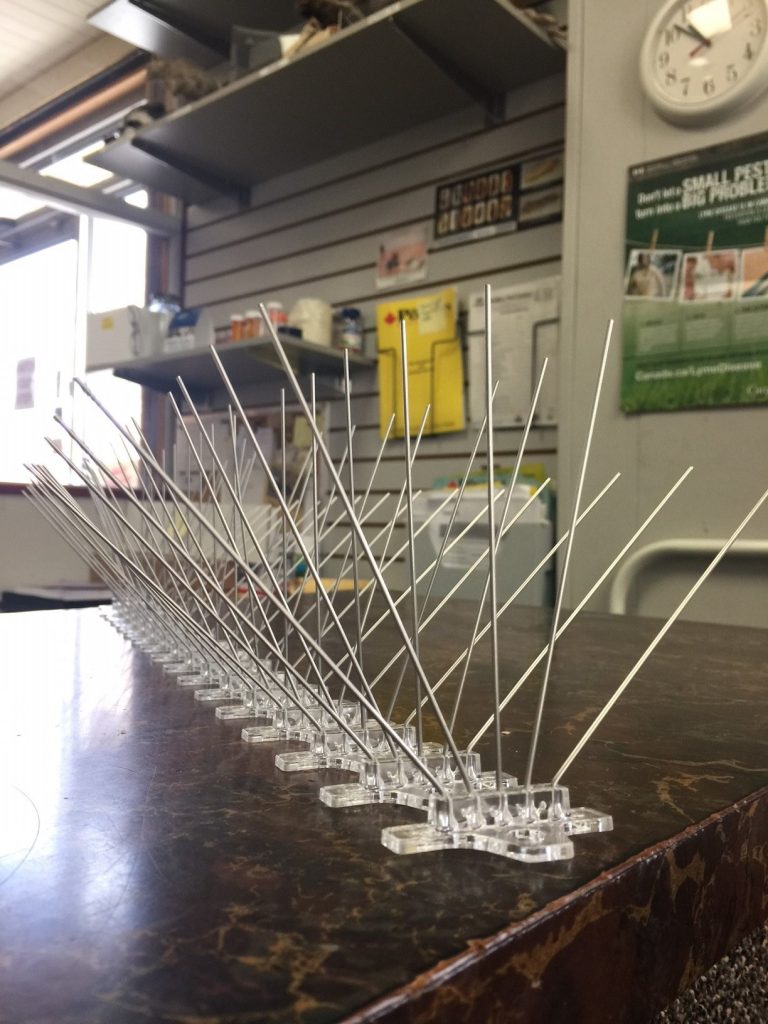
PIGEON
Scientific Name: Columbidae Common Name: Pigeon, Dove, Rock Pigeon, Feral Pigeon, Rock Dove Color: Varies Size: Between 12 – 15 inches long with a 20 – 26 inch wingspan FACT: Pigeons have color vision, a hearing range very close to that of humans and have poor senses of taste and smell. Pigeons cannot think but are capable of conditional learning.
Identification
Pigeons measure between 12 to 33 inches (30 to 84 cm). Most pigeons have round or square tails. Many members of the family have red or pink feet. The bill is slender and rounded and is usually short, with a fleshy growth at the base. The plumage is thick with metallic glints and varies in appearance from browns and grays of many temperate-zone species to the bright hues and bold patterns of tropical forms.
HABITS
There are 4 behavioural habits requiring consideration. These are feeding, nesting, roosting and loafing.
Feeding: Pigeons prefer to feed on seeds, grain, fruit etc. However, they will feed on garbage, animal matter, livestock manure and many other foods when their preferred foods are scarce.
Nesting: Nests are loosely constructed and usually consist of sticks, leaves and other debris. They are built on ledges of structures, cliffs or in caves. The considerable amount of cliff-like nesting sites, especially on older buildings, is one of the key factors that attract pigeons to cities. Often nesting and roosting occur in the same general area, but they can be distant.
Roosting: Roosting sites are where pigeons rest or sleep. They usually involve some kind of perch that is often high off the ground such as exposed roof girders, protected ledges, etc. Loafing is loosely defined as when pigeons are not feeding, nesting or roosting. This may occur almost anywhere pigeons are not constantly disturbed.
Loafing: Pigeons have very acidic droppings which can deface marble, limestone, painted surface, statues, car finishes, etc. Fresh droppings can cause objectionable odours and slippery situations on sidewalks, roads, fire escapes and other flat surfaces. Droppings, feathers and nesting materials can contaminate unprocessed grain and packaged foods. Pigeons also have diseases, ectoparasites and other pests associated with them.
Prevention
Here are five methods you have available to make sure pigeons don’t become a problem at your home or place of work:
Bird Netting – Install bird netting to prevent pigeons, and other birds or even bats from perching and nesting on your building. Netting is both effective and humane!
Bird Spiking – Install bird spikes on common landing surfaces such as ledges, window sills, rooves, and chimneys. Bird spikes will deter pigeons from landing on your building.
Noise Making or Visual Distraction Devices – You will need to be in an area that will allow these types of control options! (Usually not suitable for urban areas)
Trapping – Trapping is an option but is location specific and it’s a long-term option in removing pigeons from a site. Trapping is most effective if the birds are destroyed and not released; otherwise, they may return home or create problems elsewhere.
Baiting – A baiting program can be implemented in certain locations that will scare or deter birds from being in that area or location.
Control Methods
Pigeon control or management begins with the most important step, the survey. The survey should address the following: location of problem, species observed (pigeons/non-targets and numbers), habitat (food, water, nesting sites), special equipment, time constraints, analysis of problem, public relations issues, recommended control procedures and pricing considerations. The site should be visited on several days when typical/normal site activity and weather is occurring. On each day selected, 3 visits should be made (sunrise, midday and late afternoon) and observations should be recorded with date and time. Minimal equipment includes binoculars, a bird field identification guide, watch, site plan or map and reference manual giving biology, habits and control.
Once the species involved (pigeons and non-targets) are determined via the survey, appropriate federal, state and local regulations should be checked. Pigeons are not protected by the federal endangered species act or migratory bird statutes, but they are protected in some provinces; if the area is a bird sanctuary, then local permits are also required.
Many options are available for bird control. There are 5 methods that do not utilize toxicants. The first is exclusion which involves structural modification (eg. Change ledge angle to 45 degrees), the installation of plastic netting, and/or the use of repellents such as plastic and metal spines, monofilament and steel lines, and gels and pastes. The second is sanitation which involves the reduction or elimination of feeding sites and temporary water sources. The third involves the use of sound devices such as noise-making devices (usually not suitable for urban areas). The fourth is trapping which can be effective if the birds are destroyed and not released; otherwise, they will return home or create problems elsewhere. Finally, shooting can also be effective for removing birds within some kinds of buildings.
There are 2 methods of control utilizing chemicals or toxicants. The first can be considered a chemical frightening agent and involves grain coated with a material that of the flock being repelled. Its use involves a prebaiting program and the entire cycle may have to be repeated if other pigeons move in; it may be lethal to glutton pigeons. The second method involves contact toxicant that is administered via strategically placed perches which have an absorptive wick along their upper surface.

Geese vs. Your Property: How to Win the Battle
Ah, spring. The snow melts, the sun shines, and, like clockwork, the geese return, honking, hissing, and strutting around as if they own the place. If you’ve ever had a Canada goose glare at you like you’re the trespasser on your own lawn, you know exactly what we’re talking about. At Poulin’s Pest Control, we’re…

Pigeon Problems
The number one pest bird in North America is the common feral (wild) pigeon. They’re particularly prevalent in major centers. Like many pests, the pigeon is an invasive species. They are descended from homing pigeons brought from Europe in the 1600s as a means of carrying messages, and as food. Like most invaders, the proliferation…

Product Feature: Bird Spikes
Stainless steel bird spikes are the most effective permanent protection against bird landings. Bird spikes are a versatile product that can be easily installed on a variety of surfaces. Ledges: Birds can often be found congregating on ledges and rooftops. Install spike to keep birds from creating unsightly messes or damaging building materials.Conduits: Bird spikes…

Reasons To Control Birds
Have you ever experienced the nightly tapping on your roof over and over again, keeping you from sleeping? Complaints like these are commonplace to apartment or rental managers. It may not be the sounds that tenants and customers hear. It could be the smell they find first. Often, the culprit is a bird building a…

